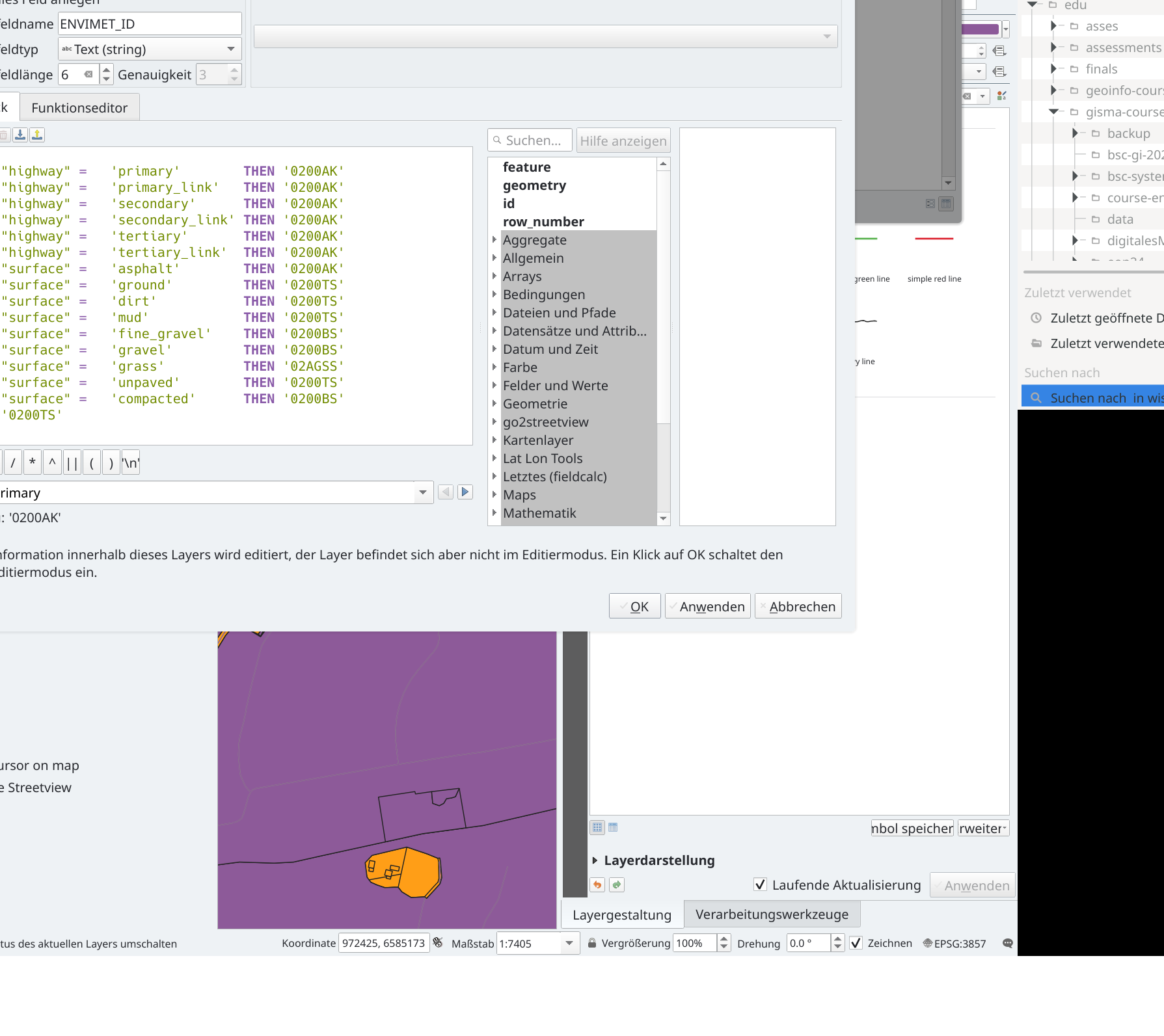- Preliminary Preparation
- Current LTR Qgis Installation
- Installation of Plugins
- Geodata to ENVI-met
- OSMDownloader
- QuickOSM
Data Aquisition
The preparation of the modelling environment for an Envimet model run can be as complex as desired, but the following criteria should always be kept in mind 1. the size and desired resolution of the model domain (depending on the research question) 2. scientific or planning level of detail of the research question 4. focus of the modelling (wind field, plant respiration, micrometeorological parameters). The input data must be selected according to these factors. In hilly terrain, a high resolution digital terrain model or digital surface model is essential. In addition, at least a rough estimate of land use and soil type is required. The three-dimensional structure of the model requires at least good estimates of vegetation and building heights in the selected model area.
For the selected question of cold air production in the Hasenkopf area, the freely available data from the State of Hesse and the Hessian Administration for Land Management and Geoinformation, as well as the Openstreetmap data, are well suited. In addition, some planning maps have to be digitised manually.
Download of the data
DEM & DOM
The DEM and DOM files relevant for Marburg can be downloaded from the website of the Hessian Administration for Land Management and Geoinformation
OSM data
Open the downloaded OSM file and search for the following elements (main keys “landuse” and “natural”)
'allotments' 'farmland' 'farmyard' 'forest' 'grass' 'meadow' 'orchard' 'village_green' 'grassland' 'scrub' 'wood' Export and project it (EPSG:32632) and name it vegtypes.gpkg.
Then select multistrings (highway key).
primary' 'primary_link' 'residential' 'secondary' 'secondary_link' 'tertiary' 'tertiary_link' 'trackExport and project it (EPSG:32632) and name it surftypes_2.gpkg.
Polygons vegetation
Open the attribute table of vegtypes.gpkg and then the field calculator. Note a new field with 6 alphanumeric characters named ENVIMET_ID. then process the following expressions

CASE
CASE
WHEN "landuse" = 'grass' THEN '000000'
WHEN "landuse" = 'meadow' THEN '000000'
WHEN "landuse" = 'farmyard' THEN '0201H4'
WHEN "landuse" = 'forest' THEN '0000SM'
WHEN "landuse" = 'allotments' THEN '0201H4'
WHEN "landuse" = 'orchard' THEN '000051'
WHEN "natural" = 'grassland' THEN '000000'
WHEN "natural" = 'wood' THEN '0000SM'
WHEN "natural" = 'scrub' THEN '0100H2'
ELSE '000000'
ENDSave the file.
Polygons surface 1
Open the attribute table of vegtypes.gpkg and the field calculator and edit the following expressions:
CASE
WHEN "landuse" = 'farmland' THEN '02AGSS'
WHEN "landuse" = 'residental' THEN '02AGSS'
WHEN "landuse" = 'industrial' THEN '0200AK'
ELSE '0200AK'Save the file and name it polygons_surface_1.gpkg.
Line surface types
Buffer the different road types with 8m (primary) 5m (secondary) 4m (tertiary) and 2.5m (tracks).
Then edit the following expression:
CASE
WHEN "highway" = 'primary' THEN '0200AK'
WHEN "highway" = 'primary_link' THEN '0200AK'
WHEN "highway" = 'secondary' THEN '0200AK'
WHEN "highway" = 'secondary_link' THEN '0200AK'
WHEN "highway" = 'tertiary' THEN '0200AK'
WHEN "highway" = 'tertiary_link' THEN '0200AK'
WHEN "surface" = 'asphalt' THEN '0200AK'
WHEN "surface" = 'ground' THEN '0200TS'
WHEN "surface" = 'dirt' THEN '0200TS'
WHEN "surface" = 'mud' THEN '0200TS'
WHEN "surface" = 'fine_gravel' THEN '0200BS'
WHEN "surface" = 'gravel' THEN '0200BS'
WHEN "surface" = 'grass' THEN '02AGSS'
WHEN "surface" = 'unpaved' THEN '0200TS'
WHEN "surface" = 'compacted' THEN '0200BS'
ELSE '0200TS'
ENDSave the file as line_surface_1.gpgk. Now merge polygons_surface_1.gpkg and line_surface_1.gpgk into all_surfaces.gpgk.
Now you can run the Convert Geodata to Envimet plugin.